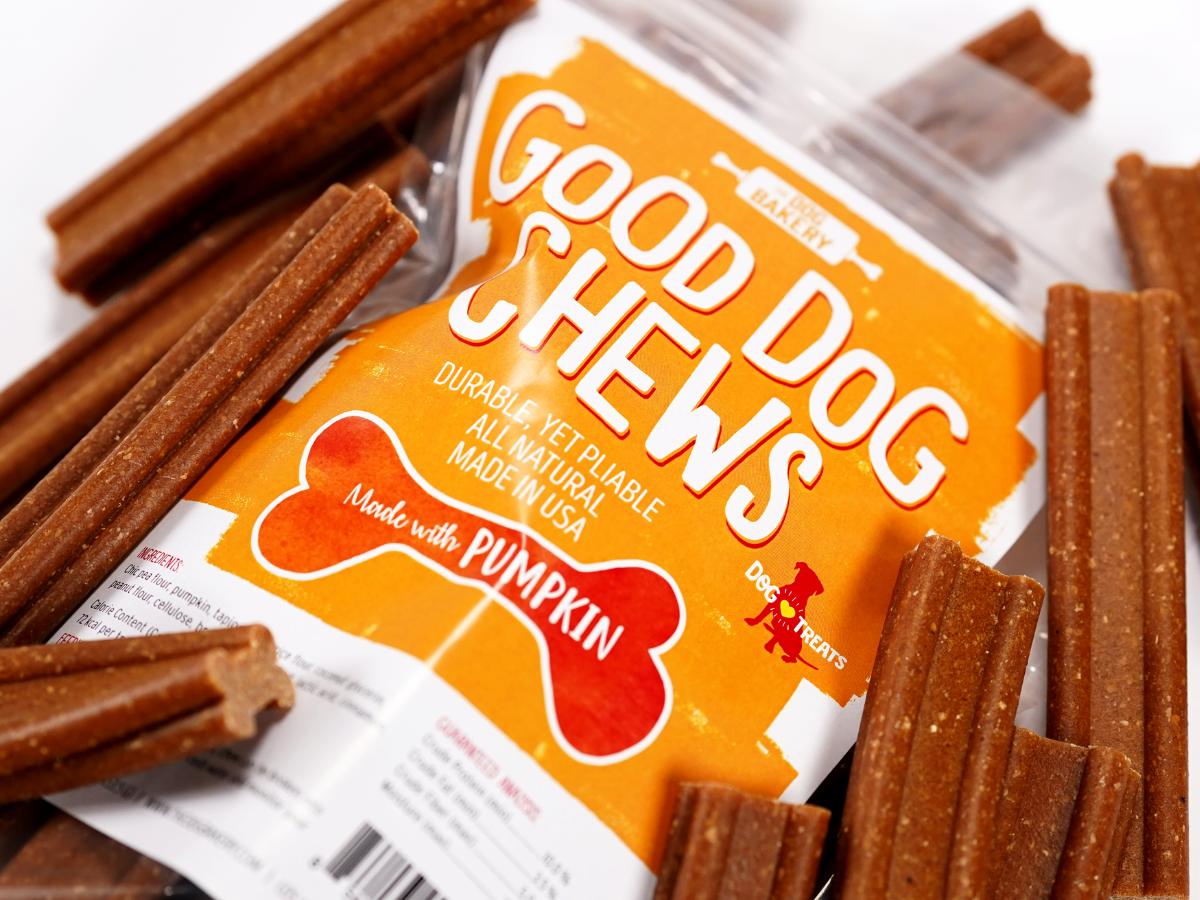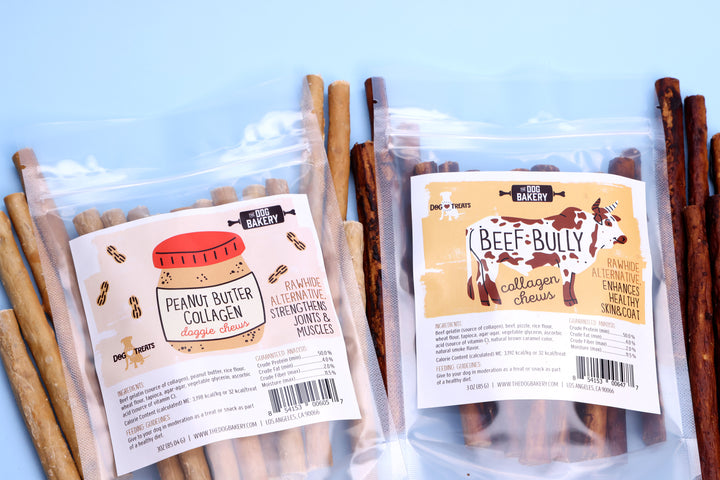Adding A Blue Merle Australian Shepherd To Your Family? Read This Before Making Any Decisions
In the Australian Shepherd breed, blue merle is a highly sought-after coat pattern, but is it as rare as people are often led to believe? Blue is a coveted color for canine enthusiasts, and merle dogs earn breeders higher profits than other common coat patterns, making blue merle dogs something of a fantasy or dream for dog lovers. But did you know that within the Australian Shepherd breed, blue merle is fairly common?
If you’ve always wanted an undeniably stunning blue merle dog, the Australian Shepherd is the breed to choose…but can your lifestyle keep up with the high intelligence and incredible energy of the Aussie Shepherd?
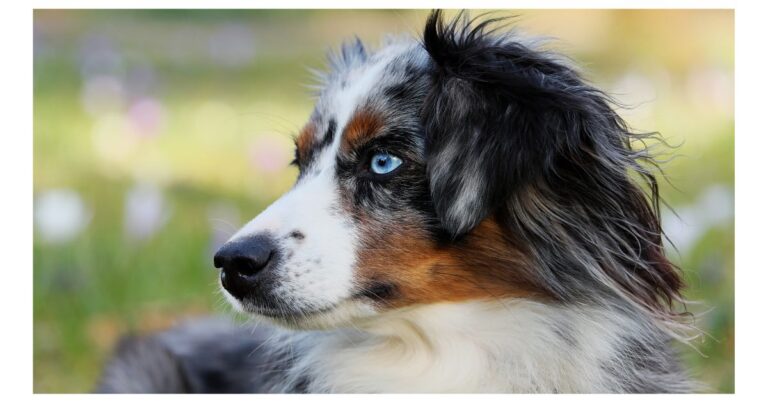
Let’s dive into the fascinating and beautiful variety of Australian Shepherd coat colors, talk about what it takes to properly care for an Aussie, and discuss the logistics of finding a reputable breeder of healthy, happy, blue merle Australian Shepherds.
Meet 5 Blue Merle Australian Shepherds from Instagram
Australian Shepherds are smart, but not quite smart enough to make their own Instagram accounts which is why we’re so grateful their humans have done it for them! Meet five blue merle Aussies showing off their beautiful coats on social media.
1. Sky
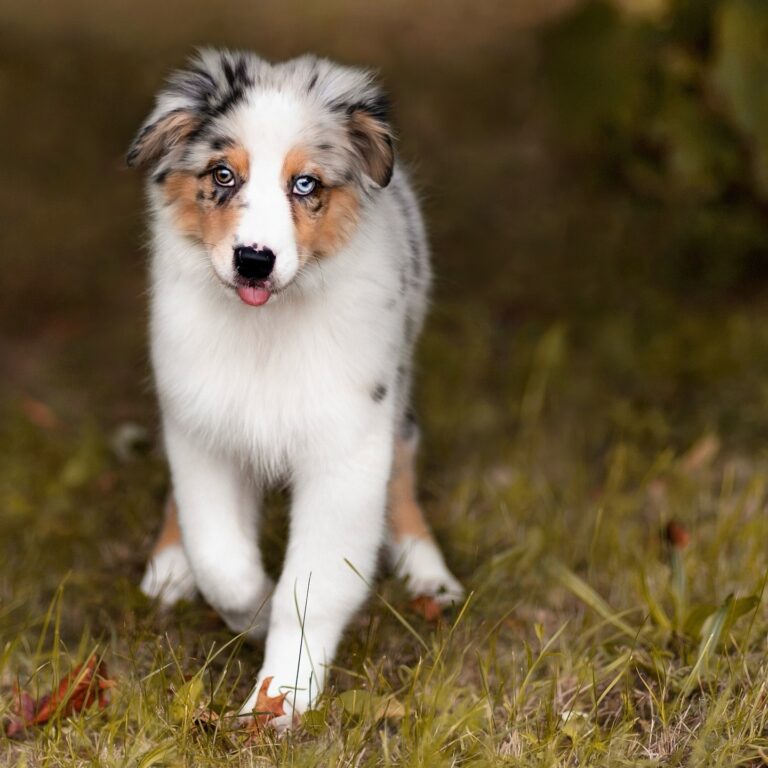
Baby Sky is a super cute blue merle Australian Shepherd puppy from Budapest, Hungary who still has lots of growing to do! Born in July of 2023, Sky isn’t even a year old yet, but we’re in no rush for her to grow out of this adorable puppy stage.
2. Koda
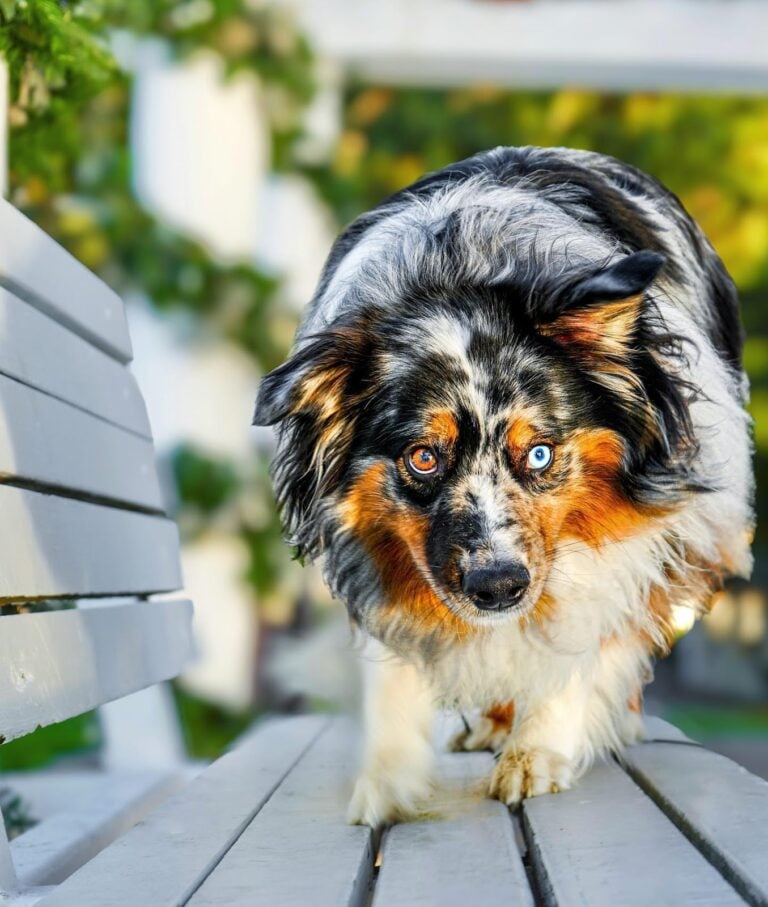
Koda is a two-year-old blue merle Australian Shepherd from Los Angeles, California whose humans say she’s a pupiranha! Australian Shepherds are famously mouthy, so it’s not surprising that Koda is a little nippy when she gets excited.
3. Aiko
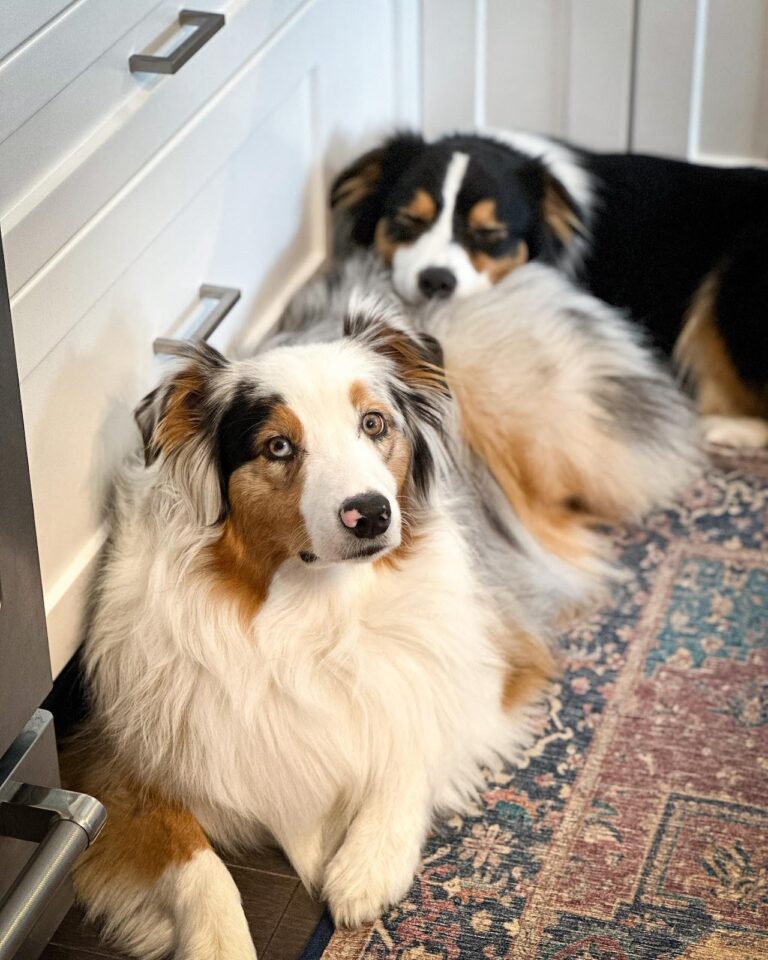
Aiko is a beautiful blue merle Aussie from Ontario, Canada whose little sister Nara (seen behind her) is a black tri Aussie! Because these are high-energy dogs, Australian Shepherds often do well with another Aussie in the home.
4. Kobe
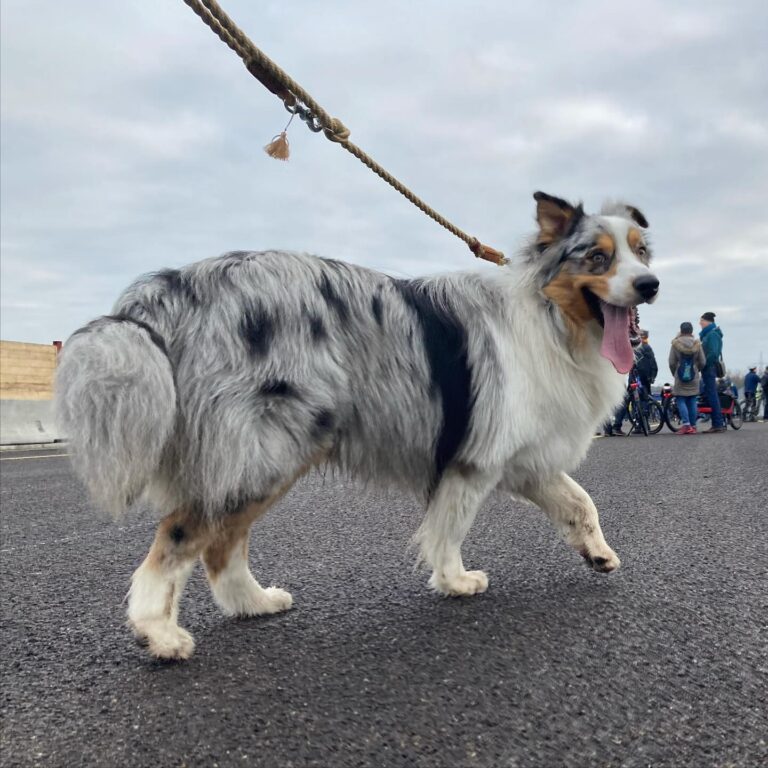
Handsome Kobe is a one-year-old blue merle Australian Shepherd from Hessen, Germany where he lives with another Aussie and a French Bulldog! A super playful boy, Kobe never says no to a walk, hike, or any activity at all.
5. Polly
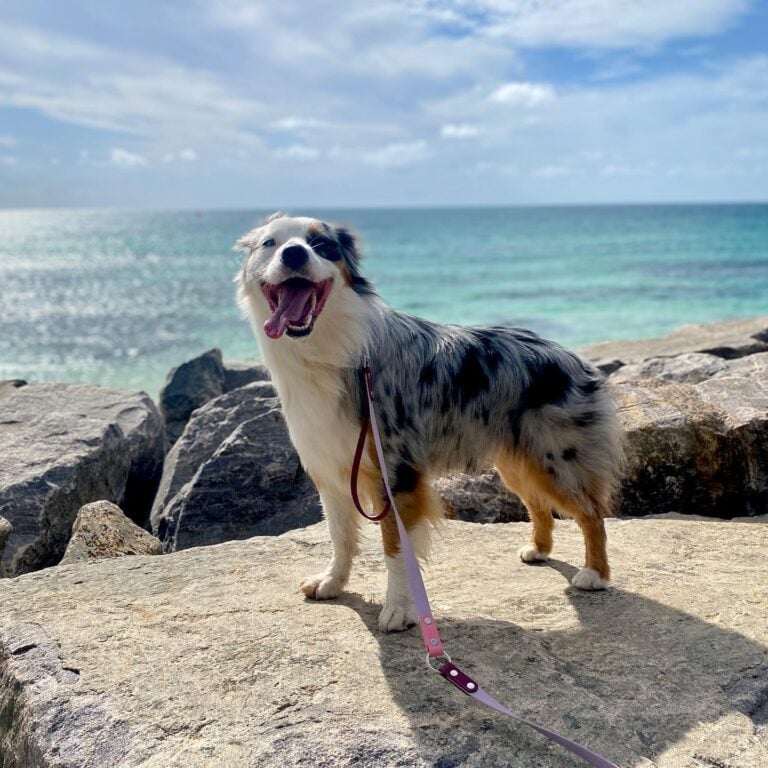
Smiley Polly is a blue merle natural bob-tail Australian Shepherd, which means she was born without a tail rather than having it docked when she was a puppy. Polly lives in Perth, Australia where she enjoys beautiful weather year-round and gets to spend lots of time outdoors with her humans!
Australian Shepherd Colors Compared
Aussie coloring is some of the most unique in the dog world, and this breed comes in a variety of colors that can make individuals look quite different from one another. According to breed standards, Aussies come in three base colors: the color black, red, and blue merle. That’s right! Blue Aussies only come in merle and are never solid blue. Australian Shepherds always have markings of some kind, and those markings can be black, white, and/or tan.
It’s also important to know that the terminology used to describe dog coat color can vary from place to place and person to person. We’ll be using the same terms throughout this blog, but here’s a little lexicon to help you in the future:
- Blue → Gray
- Red → Liver
- Tan → Copper
We’ve also whipped up an Australian Shepherd color chart covering the variety of official Australian Shepherd coat types, but we’ll also go a little more in-depth on what each coat coloring looks like and is called.
| Coat Types of Australian Shepherds | ||
| Base Coat Color | Coat Type Name | Markings |
| Black | Black Bi | Black & White |
| Black Tri | Black, White, & Tan | |
| Red | Red Bi | Red & White |
| Red Tri | Red, White, & Tan | |
| Red Merle | Red Merle w/ White Trim | |
| Red Merle | Red Merle w/ White & Tan Trim | |
| Blue Merle | Blue Bi Merle | Blue Merle w/ White Trim |
| Blue Tri Merle | Blue Merle w/ White & Tan Trim | |
Black Australian Shepherd Coat Types
Black is the most common Australian Shepherd color and comes in two basic types: Black Bi and Black Tri. You won’t find solid black or black Merle Australian Shepherds—they’ll always be either black and white or black, white, and tan.
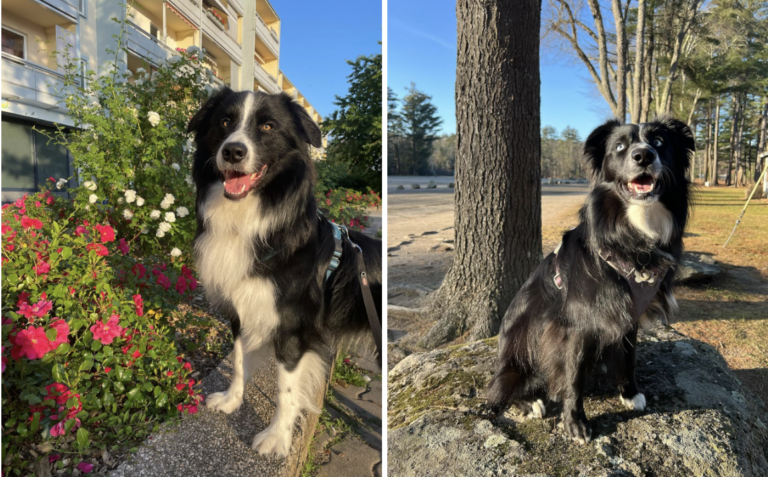
Black Bi Australian Shepherds have a solid black base coat with white markings, usually on the chest, face, and feet/legs.
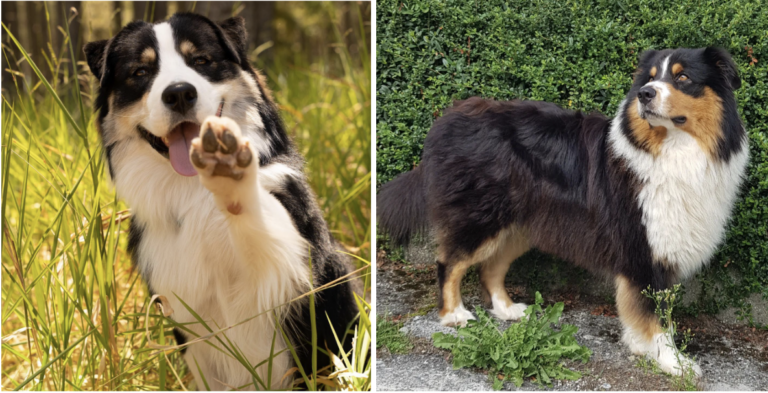
Black Tri Australian Shepherds have a black base coat with white and tan points. When an Aussie has tan marks that are a deeper, more saturated color—like the dog on the right, above—some people may also refer to this color as copper. You may also hear people call Black Tris “brown and black Australian Shepherds” but this terminology is not used by experts. It would be more accurate to call Black Tris “black and tan Australian Shepherds.”
Red Australian Shepherd Coat Types
Some people mistakenly call red Aussies “brown,” so if you ever hear someone refer to their brown and white Australian Shepherd or brown Aussies in general, know that they are probably talking about red. In the dog world, red is also sometimes called “liver.” Red Aussies come in three types: Red Bi, Red Tri, and Red Merle. Australian Shepherds are never one color, so you won’t find a solid red Australian Shepherd.
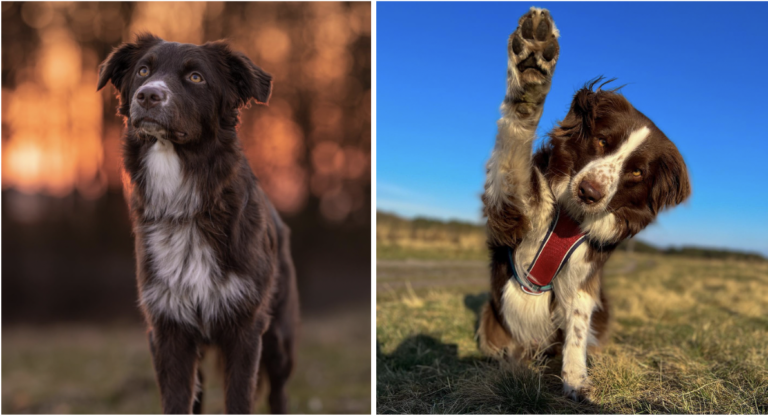
Red Bi Aussies have solid red coats with white markings. Many red Aussies have very dark-red fur, so you can see why some people might call this color brown.
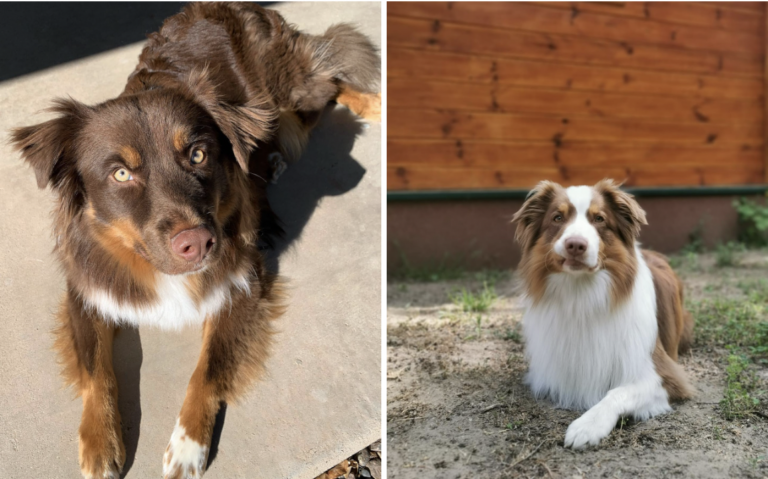
Red Tri Australian Shepherds have a solid red base coat with white and tan markings!
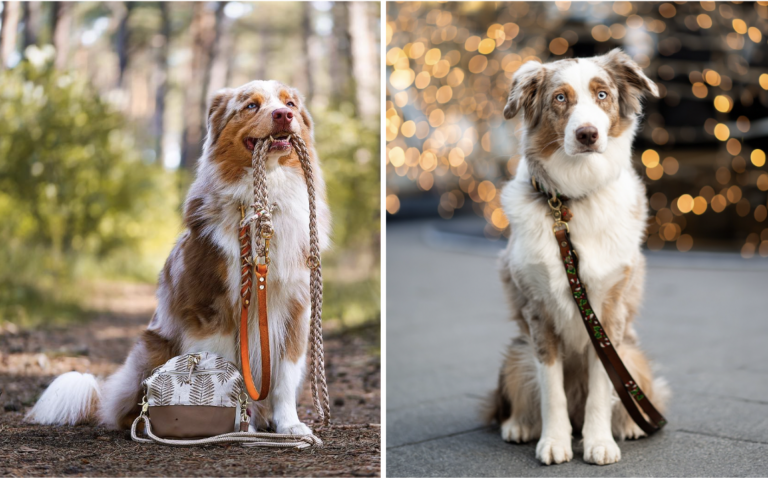
Red merle Aussies can be tri-colored or bi-colored but usually will have a white base with patches of red merle patterns and tan points. Red Merle Australian Shepherds can look quite different from one another, as you can see when you compare the two pups above, both of whom are purebreds.
Blue Merle Australian Shepherd Coat Types
Blue Australian Shepherds don’t come in solid colors at all, only merle! So you won’t find a Blue Bi or a Blue Tri—only blue merles with white or tan points. Some people may describe blue Aussies as grey Australian Shepherds, but the accepted term for a gray Australian Shepherd is “blue.” No, it’s not the bright blue you’re thinking of—it’s a steely blue-grey.
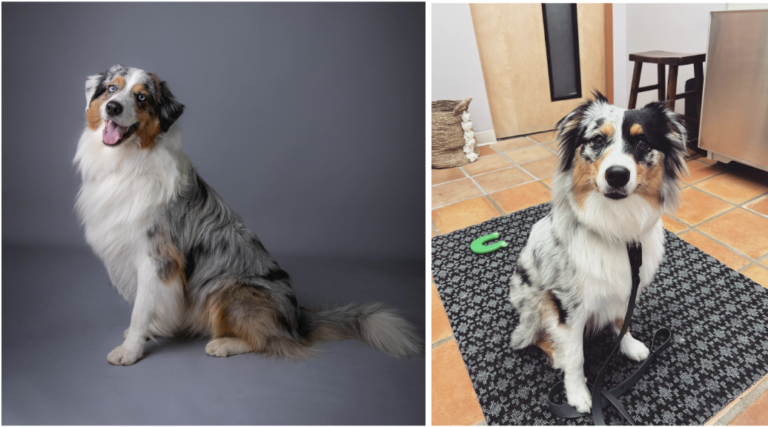
Because blue is a dilute of black, most blue merle Australian Shepherds will also have black spots. For blue merles, black is not considered an additional color but rather lumped in with the blue of their merle patterning.
Blue Merle Australian Shepherd Basic Info
The coloring of Australian Shepherds has no impact on their temperament, body composition, health, etc. Blue merle Australian Shepherds can be expected to behave and grow in the same way as any other Aussie, regardless of coat color.
While it’s very easy to fall in love with the good looks and charm of a blue merle Australian Shepherd, this is a high-maintenance breed and not your average house pet. Read the following section carefully to start learning a little about life with an Aussie.
Australian Shepherd Temperament
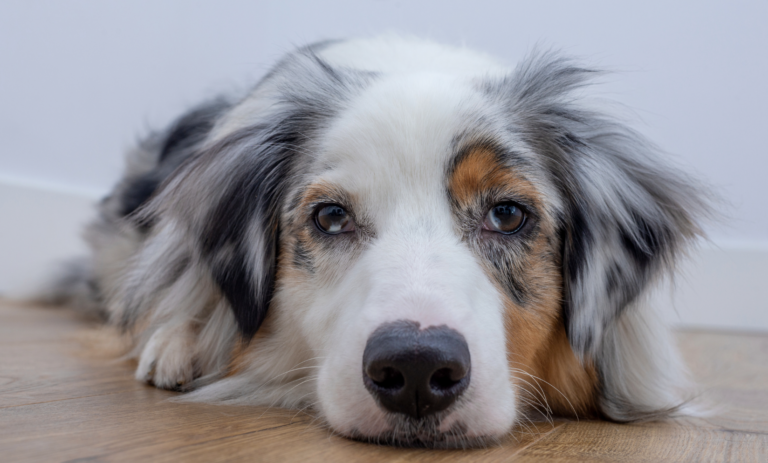
Australian Shepherds are herding dogs, originally bred by California ranchers, despite their name. Hard-working and determined, sometimes to the point of being stubborn, Australian Shepherds are happiest with a task or job to do and rarely thrive in low-activity environments.
Australian Shepherds are high energy and smart, and a bored and under-stimulated Aussie can quickly become frustrated, turning its energy towards unproductive and unwanted behaviors like herding your children, mouthiness, destructive behavior, etc. Aussies need lots of stimulation well into their senior years and are not a breed that slows down significantly with time.
“My Aussies are currently almost 4 [years old] and almost 11,” says a Reddit user’s comment describing how much exercise their Australian Shepherds need every day. “On average, 1–2 hours of walk/bike ride/ball as well as mental exercise [like] competitive obedience and rally training, tricks, [and] balance work.”
Often good with children thanks to their playful and alert nature, Aussies are often not quite so welcoming of other dogs. The instinct to herd can be intense for the Australian Shepherd, and other dogs and small animals can easily become the focus of their attention. Similarly, Aussies are a relatively high bite risk around small children whom they may try to herd and “keep in line.” No matter the breed, always supervise your children when with your dog.
Australian Shepherd Size
Aussies are medium to large dogs, and full-grown blue merle Australian Shepherds typically stand around 18–23 inches at the shoulder and weigh in at 40–65 pounds.
Blue Merle Australian Shepherd Health
There is only one health issue associated with blue merle Aussies specifically, and it relates to the merle gene. When two Australian Shepherds carrying the merle gene are mated, their puppies have the chance of inheriting two copies of the gene, making them double merles. Double merle dogs are born solid white, blind and/or deaf, and can have serious deformities that can require surgical intervention.
Reputable breeders always test their mating pairs to avoid producing double merles, and this is the only concern related to blue merle Aussies. Other breed-specific health concerns to be aware of if you own an Australian Shepherd include:
- Joint issues (e.g. hip & elbow dysplasia)
- Eye and vision problems (e.g. cataracts)
- Earwax buildup and ear infections
- Dental disease
- Epilepsy
- Certain cancers
Where To Find Reputable Blue Merle Australian Shepherd Puppy Breeders
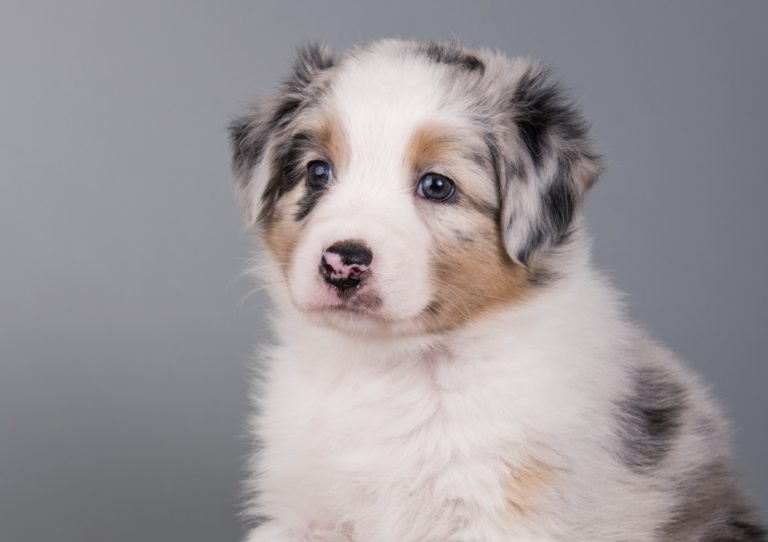
The best resource for finding reputable breeders of blue merle Australian Shepherds is through the Australian Shepherd Club of America’s breeder referral program or by searching the American Kennel Club’s breeder marketplace.
It is also possible to find blue merle Australian Shepherds for adoption at local animal rescues and humane societies, or through breed-specific rescues like Aussie Rescue & Placement Hotline Inc. and Australian Shepherds Furever.
Blue Merle Aussie FAQ
Craving more facts about the blue merle Australian Shepherds? Read our responses to the most commonly asked questions about the breed.
How much does a blue merle Australian Shepherd cost?
Most Australian Shepherd breeders price their puppies around $700–$2,000, with most selling for an average of about $1,300. Blue merle is not exactly a rare color, but blue merles may cost slightly more than black tris/bis or reds.
Can miniature Australian Shepherds be blue merle?
Yes! There are two Australian Shepherd types: standard and miniature. Blue merle mini Australian Shepherds are just as common as blue merle standard Aussies but are only 3–18 inches tall and weigh about 20–35 pounds—much smaller than the standards. Mini Aussies are also called Miniature American Shepherds, so you may see breeders advertise them as “blue merle mini American Shepherds.” Here are two adorable examples!
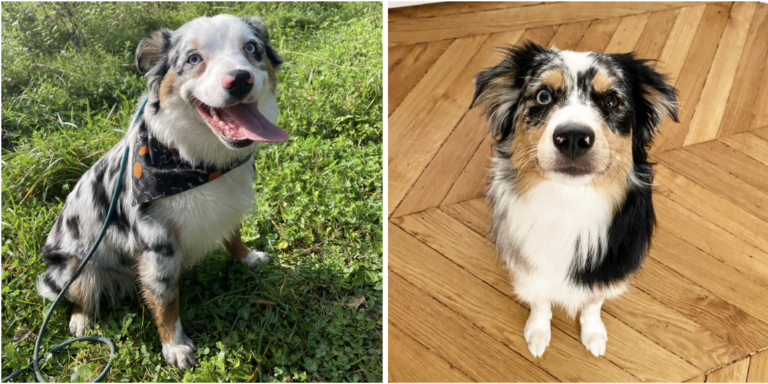 Sources: @Adventures_With_Chunky and @Champa.Aussie
Sources: @Adventures_With_Chunky and @Champa.Aussie
What color eyes do blue merle Australian Shepherds have?
Australian Shepherds are known for having amazing eye colors, but the merle gene can make their eyes even more amazing! The merle gene can remove pigment not only from a dog’s coat but from their eyes, too, which means many blue merle Aussie Shepherds also have fully or partially blue eyes. Some blue merles have something called heterochromia, or two different colored eyes!
Is blue merle the rarest Australian Shepherd color?
No. There are no truly rare Australian Shepherd colors, but if we look at the percentages, red merle Australian Shepherds are technically the most rare. For the Australian Shepherd blue merle is relatively common, especially in comparison to other breeds where both blue and merle are rare.
Do all brown Australian Shepherds exist?
No. Firstly, Australian Shepherds are never one single color, they are always at least two colors—a base color and white. Secondly, the color sometimes mistakenly referred to as “brown” is actually called red or liver in the dog world. Aussies do come in red, but they are never solid red.
Related Articles:
- Fur or Foe? The Real Deal on Australian Shepherds and Allergies
- 6 Biologically Appropriate Dog Foods for Australian Shepherds
- Meet The Aussie German Shepherd Mix


